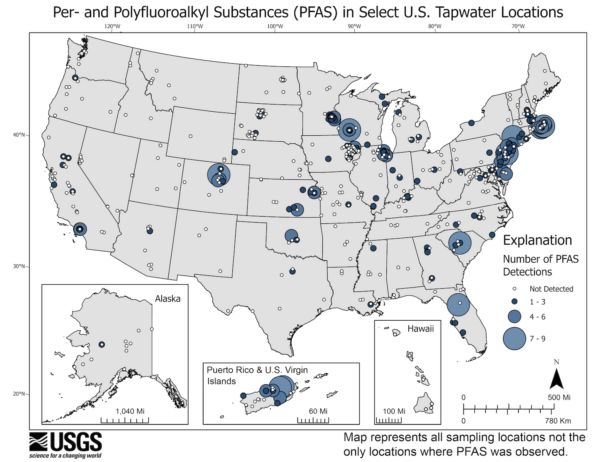Alarm-Reporting Watchman There May Be So-Called “Forever Chemicals” in as Much as Half of the Nation’s Tap Water

HNewsWire:
The study by the U.S. Geological Survey tested for the presence of 32 types of PFAS from samples taken from 716 locations—269 private wells and 447 public supply—across the nation from 2016 to 2021.
Based on these samples, USGS researchers determined by modeling that, on average, at least one PFAS is detected in about 45 percent of U.S. tap water.
There are more than 12,000 types of PFAS, which are invisible man-made chemicals, high levels of which have been linked to adverse health issues, including various cancers, reproductive issues, and adverse effects on immune function. But not all of the PFAS types can be detected with current tests.

“USGS scientists tested water collected directly from people’s kitchen sinks across the nation, providing the most comprehensive study to date on PFAS in tap water from both private wells and public supplies,” USGS research hydrologist Kelly Smalling, the study’s lead author, said in a statement on July 5.
“The study estimates that at least one type of PFAS—of those that were monitored—could be present in nearly half of the tap water in the U.S. Furthermore, PFAS concentrations were similar between public supplies and private wells.”
PFAS are colloquially referred to as “forever chemicals” because they don’t easily break down in the human body or the environment, and some of them never fully break down. These substances are known for their resistance to grease, oil, water, and heat, and as such, can be used in a wide range of products, including non-stick cookware, stain- and water-resistant fabrics and carpets, as well as cleaning products, paints, water repellents, and fire-fighting foams.

According to the USGS, the study marks “the first time anyone has tested for and compared PFAS in tap water from both private and government-regulated public water supplies” on a broad scale throughout the United States.
“Those data were used to model and estimate PFAS contamination nationwide. This USGS study can help members of the public to understand their risk of exposure and inform policy and management decisions regarding testing and treatment options for drinking water,” the agency said in a release.
More Risk of PFAS Exposure in Urban Areas
Urban areas are more at risk of PFAS exposure compared to rural areas, with the forever chemicals detected in over 70 percent of urban areas or areas with a known history of PFAS contamination, compared to 8 percent of rural areas. Researchers observed the exposure in urban areas including around the Great Plains, Great Lakes, Eastern Seaboard, and Central/Southern California regions.
The most frequently detected compounds in this study were PFBS, PFHxS, and PFOA.
USGS researchers estimate the probability of not detecting PFAS above their detection limits is about 25 percent in urban centers or areas with a known history of PFAS contamination and more than 75 percent in rural areas.
The EPA in March proposed national drinking water limits for the two most widely used PFAS, known as PFOA and PFOS. Their levels will be limited to at most four parts per trillion (ppt) in drinking water, according to the proposal. One ppt is the equivalent of one drop of contaminant in 18 million gallons of water.
According to the U.S. Agency for Toxic Substances and Disease Registry, blood PFAS levels among Americans have decreased since 2002, when production and use of PFOS and PFOA in the United States declined. After two decades, however, most Americans still have detectable levels in their blood.
The EPA regulates public water supplies, while homeowners are responsible for testing and treating private water supplies.
“Those interested in testing and treating private wells should contact their local and state officials for guidance,” the USGS said in its release. “Testing is the only way to confirm the presence of these contaminants in wells.”
For more information about PFAS regulations, visit the EPA’s website on addressing PFAS.

Revelation: A Blueprint for the Great Tribulation


A Watchman Is Awakened


Will Putin Fulfill Biblical Prophecy and Attack Israel?



Newsletter
Orphans

Editor's Bio












